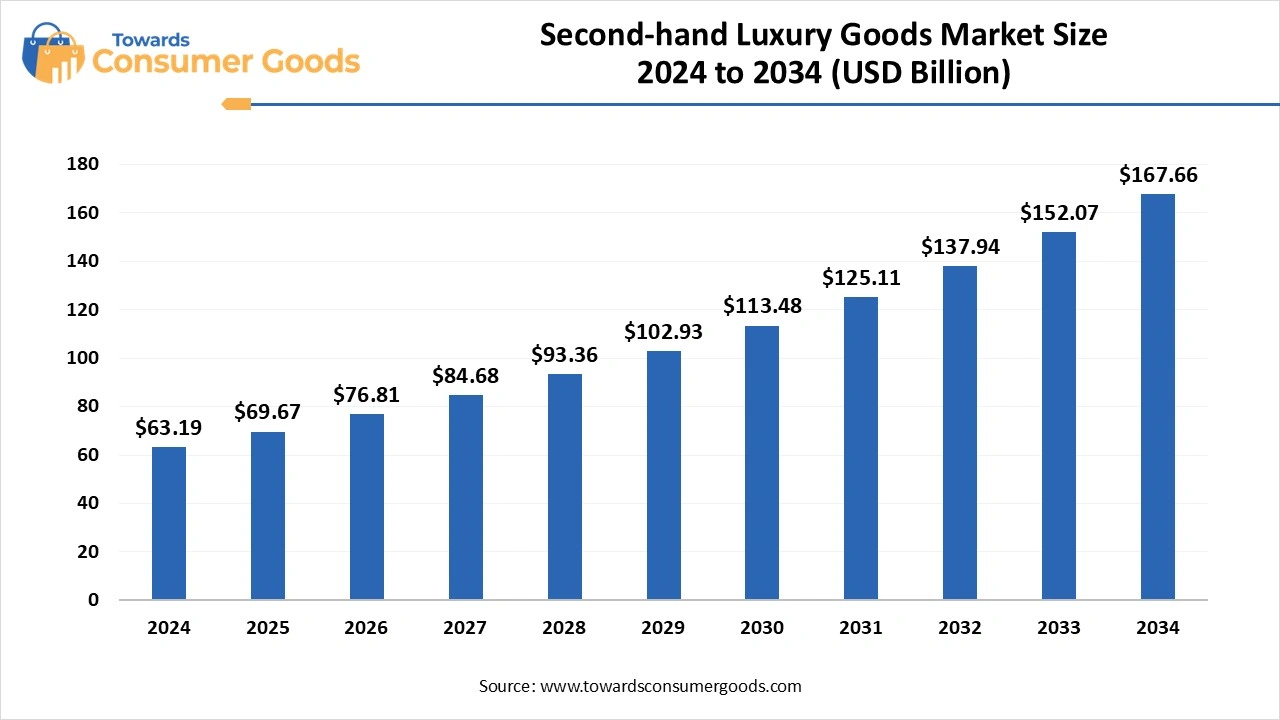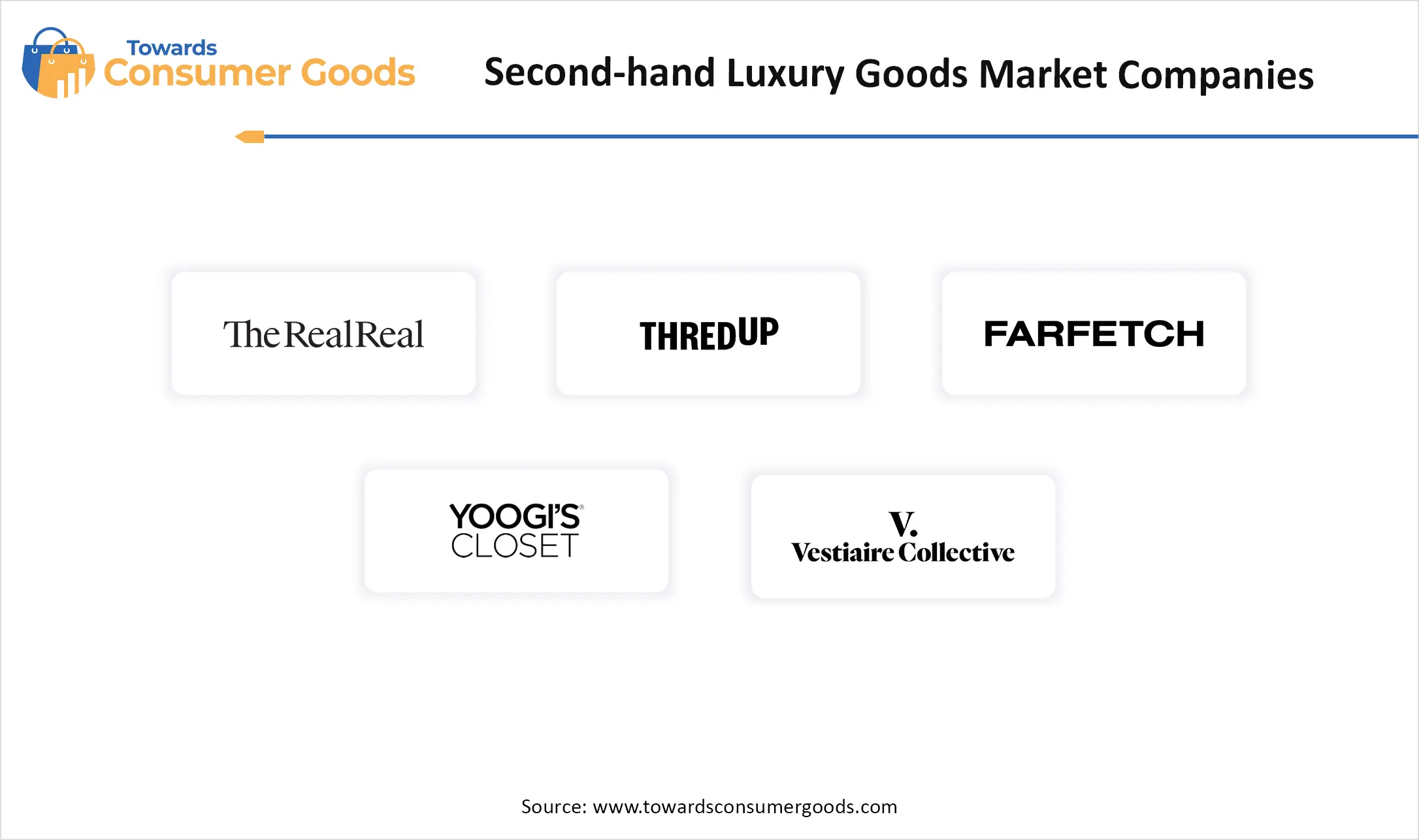July 2025
The global second hand luxury goods market size accounted for USD 63.19 billion in 2024 and is predicted to increase from USD 69.67 billion in 2025 to approximately USD 167.66 billion by 2034, expanding at a CAGR of 10.25% from 2025 to 2034.
The second-hand luxury goods market has transformed from a niche corner of fashion to a booming global industry, fueled by shifting consumer mindsets and sustainability values. Buyers are increasingly embracing pre-owned designer products for their affordability, exclusivity, and lower environmental impact.

The second-hand luxury market is now a huge industry, witnessing strong year-on-year growth. The trend is driven by Gen Z and millennials, who value both economic and environmental sustainability. Fashion-forward consumers are no longer hesitant to invest in pre-owned designer handbags, watches, apparel, jewelry, and accessories, especially when authenticity is guaranteed through digital platforms. Luxury resale platforms like The Real, Vestiaries Collective, and Rebag have revolutionized this space by introducing AI-driven authentication, detailed product histories, and certified condition grading.
The online segment is booming, while offline consignment boutiques continue to cater to affluent, style-savvy urban shoppers. Additionally, traditional luxury brands such as Gucci and Burberry are themselves entering the resale arena through partnerships and in-house buyback programs, signaling legitimacy and long-term potential for this market.
| Report Attributes | Details |
| Market Size in 2025 | USD 69.67 Billion |
| Expected Size by 2034 | USD 167.66 Billion |
| Growth Rate from 2025 to 2034 | CAGR 10.25% |
| Base Year of Estimation | 2024 |
| Forecast Period | 2025 - 2034 |
| Dominant Region | Europe |
| Segment Covered | By Product, By Distribution Channel, By Region |
| Key Companies Profiled | The RealReal, Inc., ThredUp, Inc., Farfetch Limited, Alibaba Group (Idle Fish), Yoogi's Closet, Inc., Vestiaire Collective, Timepiece360, The Luxury Closet, Luxepolis Retail Services Pvt Ltd., (Luxepolis.com), Garderobe, Fashionphile Group, LLC, Inseller |
| Gen Z (18-24) | Gen X (41-55) |
| Buying behavior values sustainability, ethical consumption, and unique fashion expression. Mobile-first platforms like Depop, Poshmark, and Insta Boutiques | This set of audience prefers authentic and certified pre-owned goods. The preferred channels in brick-and-mortar consignment stores, auction houses, and authenticated online platforms. |
From Closet to Commerce: A Circular Goldmine Awaits
The rising popularity of the circular economy is opening vast opportunities in the second-hand luxury market. As consumers and regulators alike demand more sustainable practices, luxury resale is becoming a powerful solution for reducing fashion waste and extending product lifecycles. With a growing number of eco-conscious Gen Z and Millennial consumers entering the luxury market, brands and platforms can tap into a younger, more digitally native audience. By integrating resale into their core business models through buy-back programs, certified pre-owned sections, or white-label resale partnerships, luxury brands can enhance brand loyalty, attract price-sensitive consumers, and boost lifetime value.
Moreover, technological advancements such as AI-based authentication, blockchain provenance tracking, and digital storefronts are helping build trust and scale operations globally. Emerging economies like India, China, and Southeast Asia, where aspirational demand is rising, present significant untapped potential for second-hand luxury, particularly in Tier 2 and Tier 3 cities through mobile-first platforms. In short, luxury resale is no longer just an afterthought; it is a strategic growth frontier with room for innovation, global expansion, and brand redefinition.
There are some restraints, like consumer trust and product authenticity. Unlike new products bought directly from a brand, pre-owned items often pass through multiple owners, which raises concerns over counterfeiting, tampering, and quality inconsistency. High-profile cases of counterfeit goods, especially on peer-to-peer marketplaces, have made some consumers hesitant to participate, particularly those from older generations or emerging markets. Even with improved verification systems, 100% authenticity assurance remains difficult without brand-backed resale models or blockchain-based product histories.
Why Is Europe Leading the Second-hand Luxury Revolution?
Europe stands tall as the dominant region in the second-hand luxury goods market, thanks to its rich luxury heritage, established resale culture, and mature fashion ecosystem. Home to prestigious fashion houses like Louis Vuitton, Chanel, Hermès, Gucci, and Dior, Europe naturally became the epicenter of both first-hand and second-hand luxury commerce. Countries like France, Italy, Germany, and the United Kingdom have witnessed a generational acceptance of vintage and pre-owned fashion. European consumers value timeless craftsmanship, sustainable fashion, and investment-driven purchases, which align perfectly with the ethos of second-hand luxury.
Additionally, the region has a dense network of high-end consignment stores, auction houses, and online resale platforms, giving both buyers and sellers convenient access and security. Moreover, EU sustainability regulations and ESG goals have pushed luxury brands to incorporate circular fashion models, making resale an essential part of their growth strategy. For example, luxury retailers in Paris or Milan now often collaborate with authenticated resellers or host dedicated sections for certified pre-owned products.
The presence of fashion-forward cities, strong digital infrastructure, and social acceptance of pre-owned luxury make Europe the benchmark market in this space. Consumers here no longer see resale as secondary; they see it as smart, ethical, and stylish.
How Is Asia-Pacific Becoming the Fastest-Growing Luxury Resale Market?
The Asia-Pacific region is undergoing a resale renaissance, rapidly emerging as the fastest-growing market for second-hand luxury goods. This growth is fueled by rising disposable incomes, brand-conscious millennials, and a growing appetite for affordable luxury across diverse markets from China and India to Southeast Asia and Australia.
Traditionally, luxury ownership in Asia symbolized status and social prestige. However, Gen Z and Millennial consumers are now embracing resale platforms to enter the luxury world at accessible price points, while also experimenting with vintage and limited-edition pieces. This generational shift is evident in cities like Shanghai, Mumbai, Jakarta, and Seoul, where young consumers are driving demand for authenticated, gently-used luxury items often via mobile-first e-commerce platforms.
The market is further supported by the rapid digitization of retail, with social commerce, influencer-driven resale trends, and app-based platforms gaining immense traction. In India, for instance, fashion startups are emerging to address urban demand for second-hand designer wear. In Japan and South Korea, where thrift culture is more established, high-quality curation and meticulous grading standards have made second-hand luxury not only accepted but also aspirational. However, what sets Asia-Pacific apart is the sheer volume of aspirational consumers entering the market. As urbanization spreads and the middle class expands, the resale market is witnessing double-digit growth year-on-year, making it the region to watch for long-term investment and brand localization strategies.
Why Are Other Luxury Leather Goods Leading the Resale Market?
Other luxury leather goods are leading the second-hand luxury goods market, like wallets, belts, luggage, briefcases, and small leather accessories have taken the lead in dominance. Their relatively lower price points, compact size, and functional appeal make them ideal entry points for consumers exploring the luxury resale space. These items typically experience less wear and tear compared to handbags or shoes, which enhances their resale value and longevity. Furthermore, buyers often see them as everyday luxury companions, blending utility with prestige.
Brands like Louis Vuitton, Prada, and Bottega Veneta are known for producing timeless leather accessories that retain value and style across seasons. Additionally, these leather goods are frequently purchased as gifts, making them highly circulated items in both primary and secondary markets. Their smaller size also enables easier authentication, packaging, and shipping, making them particularly suitable for online resale platforms.
On the other hand, handbags are emerging as the fastest-growing product segment in the second-hand luxury market due to their iconic status, emotional appeal, and high investment value. Unlike most fashion products, a well-preserved luxury handbag can appreciate, especially models like the Hermès Birkin, Chanel Classic Flap, or Dior Saddle. Modern consumers, especially millennials and Gen Z, view handbags not just as accessories but as fashion statements and status symbols. These bags often carry historical and sentimental significance, making them the most photographed and flaunted items in luxury wardrobes and, hence, highly sought after in resale. Platforms and boutiques increasingly offer handbag authentication services, condition grading, and even instalment-based payment options, boosting consumer confidence in making high-value second-hand purchases. The allure of owning a luxury bag at a reduced price without compromising on elegance continues to fuel demand.
Why Is Online Resale the Go-To for Luxury Shoppers?
Online channels have become the dominating force in the second-hand luxury goods market. They offer global reach, real-time inventory access, competitive pricing, and digital authentication features meeting the expectations of today’s tech-savvy, convenience-driven buyers. Platforms such as The RealReal, Vestiaire Collective, and Poshmark enable consumers to browse, purchase, and even sell luxury items with minimal friction. Features like AI-driven pricing tools, condition grading, and virtual customer service further enrich the buyer experience. Additionally, online resale offers greater transparency with product histories, and in many cases, returns and buyer protection guarantees, which are crucial for high-ticket items. The growth of social commerce resale via Instagram, Facebook Marketplace, and TikTok has also made online second-hand shopping feel personal, fast, and fashionable.
Moreover, while online dominates, offline retail is the fastest-growing distribution channel, thanks to the immersive and tactile shopping experience it offers. Consumers, especially those buying high-value items, often prefer to see, feel, and try products in person before purchasing. Luxury consignment boutiques and second-hand stores provide in-store authentication, expert curation, and personalized service, making the process trustworthy and enjoyable. For older demographics or first-time luxury buyers, this physical reassurance plays a key role in purchase decisions. Moreover, luxury department stores and even some flagship brand stores are beginning to incorporate resale sections or certified pre-owned counters, seamlessly integrating new and pre-owned luxury in one location. This hybrid model is gaining traction, especially in urban centers with high luxury consumption.

By Product
By distribution channel
By geographical region
July 2025
June 2025
June 2025
May 2025